Renal tumor pathology has developed significantly, increasing from two essential forms of renal malignant tumors to over 20 distinct varieties. Diagnostic standards have superior from purely morphological options to incorporate histochemistry, immunohistochemistry (IHC), and molecular genetics. The World Well being Group (WHO) and the Worldwide Society of Urologic Pathology (ISUP) have been instrumental in updating these standards, leading to a complete framework important for correct analysis, efficient remedy, and improved affected person outcomes.
The sector of renal tumor pathology has undergone important developments, notably with the introduction of recent molecular information and remedy approaches. The 2022 WHO classification of kidney epithelial tumors displays these developments with main updates from the earlier 2016 classification. This evaluation outlines the diagnostic updates and main modifications within the classification of kidney epithelial tumors, emphasizing the rationale behind these modifications.
Regardless of the rise of molecular strategies, morphological and cytological options stay the cornerstone of renal tumor classification. The 2022 WHO classification displays this by persevering with to prioritize morphological standards whereas incorporating molecular genetics for extra exact diagnostics. This twin method ensures each conventional and fashionable diagnostic strategies are utilized, offering a complete understanding of renal tumors.
The 2022 classification reorganizes renal epithelial tumors hierarchically, beginning with benign tumors adopted by malignant ones. This new construction aligns with a unified method throughout all WHO Blue Books. Tumors are categorized primarily based on their morphological and cytological options into clear cell renal tumors, papillary renal tumors, oncocytic and chromophobe renal tumors, amassing duct tumors, different renal tumors, and molecularly outlined renal carcinomas. This group streamlines the diagnostic course of and enhances readability in tumor classification.
Important modifications have been made to the classification of established renal tumors:
Papillary Renal Cell Carcinoma (PRCC): The subtyping into kind 1 and kind 2 has been abolished. Traditional PRCC now encompasses tumors beforehand categorised as kind 1, whereas kind 2 tumors have been reclassified into different classes. This transformation addresses overlapping options and organic behaviors, simplifying analysis.
Clear Cell Papillary Renal Cell Tumor (CCPRCT): Beforehand often known as clear cell PRCC, this tumor has been renamed on account of its persistently indolent habits, distinguishing it from extra aggressive tumors and guaranteeing applicable administration.
Chromophobe Renal Cell Carcinoma (ChRCC): Acknowledges non-conventional morphologies and introduces “different oncocytic tumors” for tumors with blended options, aiding in correct analysis and remedy planning.
RCC-Not In any other case Specified (RCC-NOS): Replaces the time period RCC-Unclassified for tumors that don’t match into different classes, reflecting a extra exact method to categorizing renal tumors.
A brand new class for molecularly outlined tumors has been established, reflecting developments in molecular diagnostics. This consists of tumors with particular genetic alterations, comparable to TFE3-rearranged RCCs, TFEB-altered RCC, and ELOC-mutated RCC. These tumors require molecular checks for definitive analysis, highlighting the mixing of molecular genetics in fashionable pathology.
The 2022 WHO classification has important scientific and diagnostic implications. By integrating molecular information with conventional histopathological standards, it offers a nuanced and exact framework for diagnosing renal tumors. This integration facilitates correct prognostication and customized remedy methods, bettering affected person outcomes. The up to date classification underscores the necessity for pathologists and clinicians to remain present with developments in molecular diagnostics and their scientific implications.
The 2022 WHO classification of kidney epithelial tumors marks a major development in renal tumor pathology. By incorporating each conventional morphological standards and fashionable molecular information, the classification offers a complete framework for the analysis, classification, and administration of renal tumors. This evolution paves the way in which for precision medication, providing extra tailor-made and efficient remedy choices for sufferers. The continued updates in renal tumor classification mirror the dynamic nature of the sphere, emphasizing the continual want for analysis and adaptation in pathology to boost affected person care.
Adopting these new classifications requires ongoing training and adaptation amongst healthcare suppliers. Future analysis ought to give attention to refining these classifications and exploring the scientific implications of newly recognized molecular subtypes. As the sphere progresses, the mixing of novel diagnostic instruments and therapies will proceed to rework renal tumor pathology, underscoring the significance of a multidisciplinary method in managing kidney most cancers.
Supply:
Journal reference:
Mubarak, M., & Rashid, R. (2024). Updates from the 2022 WHO Classification of Kidney Epithelial Tumors. Journal of Medical and Translational Pathology. doi.org/10.14218/JCTP.2024.00002.


